-
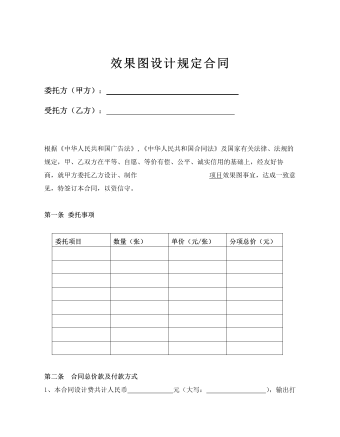
效果图设计规定合同
根据《中华人民共和国广告法》,《中华人民共和国合同法》及国家有关法律、法规的规定,甲、乙双方在平等、自愿、等价有偿、公平、诚实信用的基础上,经友好协商,就甲方委托乙方设计、制作 项目效果图事宜,达成一致意见,特签订本合同,以资信守。第一条 委托事项委托项目 数量(张) 单价(元/张) 分项总价(元)第二条 合同总价款及付款方式1、本合同设计费共计人民币 元(大写: ),输出打样等其他费用为人民币 元(大写: ),总价款为人民币 元(大写: )。前述费用已包括税费,如有需要增加新角度,则在补充合同上另行商定。2、本合同签订后1个工作日内,甲方应向乙方支付合同总价款的50%,即人民币(大写): 。3、乙方交付设计成果后当日内,甲方向乙方支付合同结算余款。第三条 双方义务1、甲方负责在约定的时间内提供乙方设计所需的项目详细资料,且乙方仅需在甲方提供的资料范围内制作效果图,如超出制作效果图范畴的应按照设计费计算方式结算制图费,并对其所提供的资料的合法性负责:2、甲方应按合同约定向乙方支付本合同价款。
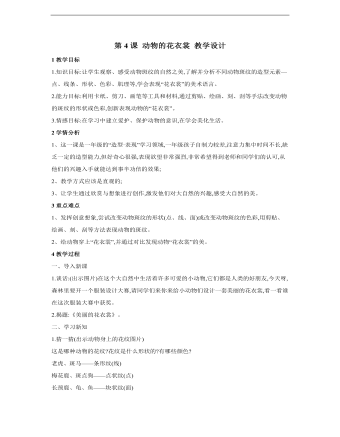
小学美术桂美版一年级上册《第4课动物的花衣裳》教学设计说课稿
2学情分析 1、这一课是一年级的“造型·表现”学习领域,一年级孩子自制力较差,注意力集中时间不长,缺乏一定的造型能力,但好奇心很强,表现欲望非常强烈,非常希望得到老师和同学们的认可,从他们的兴趣入手就能达到事半功倍的效果;2、教学方式应该是直观的;3、让学生通过欣赏与想象进行创作,激发他们对大自然的兴趣,感受大自然的美。
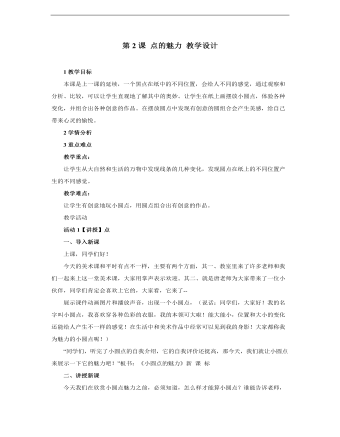
小学美术人教版四年级下册《第2课点的魅力2》教学设计说课稿
一、导入新课上课,同学们好!今天的美术课和平时有点不一样,主要有两个方面,其一、教室里来了许多老师和我们一起来上这一堂美术课,大家用掌声表示欢迎。其二、就是唐老师为大家带来了一位小伙伴,同学们肯定会喜欢上它的,大家看,它来了--展示课件动画图片和播放声音,出现一个小圆点,(说话:同学们,大家好!我的名字叫小圆点,我喜欢穿各种色彩的衣服,我的本领可大啦!能大能小,位置和大小的变化还能给人产生不一样的感觉!在生活中和美术作品中经常可以见到我的身影!大家都称我为魅力的小圆点呢!)
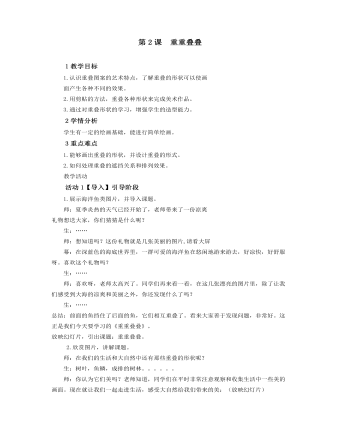
小学美术人教版二年级下册《第2课重重叠叠》教学设计说课稿
1.展示海洋鱼类图片,并导入课题。师:夏季炎热的天气已经开始了,老师带来了一份凉爽礼物想送大家,你们猜猜是什么呢?生:……师:想知道吗?这份礼物就是几张美丽的图片,请看大屏幕:在深蓝色的海底世界里,一群可爱的海洋鱼在悠闲地游来游去,好凉快,好舒服呀。喜欢这个礼物吗? 生:…… 师:喜欢呀,老师太高兴了。同学们再来看一看,在这几张漂亮的图片里,除了让我们感受到大海的凉爽和美丽之外,你还发现什么了吗?
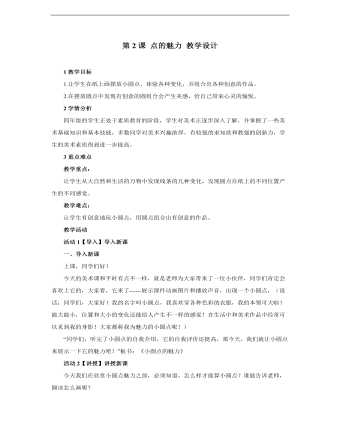
小学美术人教版四年级下册《第2课点的魅力1》教学设计说课稿
2学情分析四年级的学生正处于素质教育的阶段,学生对美术正逐步深入了解,并掌握了一些美术基础知识和基本技能,多数同学对美术兴趣浓厚,有较强的求知欲和教强的创新力,学生的美术素质得到进一步提高。3重点难点教学重点:让学生从大自然和生活的万物中发现线条的几种变化,发现圆点在纸上的不同位置产生的不同感觉。
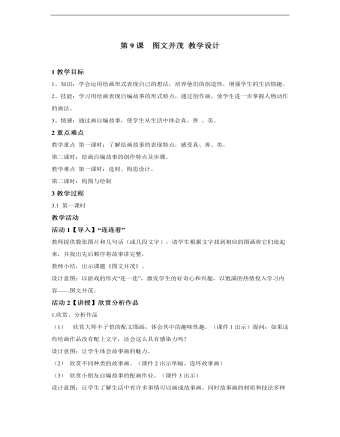
小学美术人教版六年级下册《第9课图文并茂3》教学设计说课稿
2重点难点教学重点第一课时:了解绘画故事的表现特点,感受真、善、美。第二课时:绘画自编故事的创作特点及步骤。教学难点第一课时:选材、构思设计。第二课时:构图与绘制3教学过程3.1 第一课时教学活动活动1【导入】“连连看” 教师提供数张图片和几句话(或几段文字),请学生根据文字找到相应的图画将它们连起来,并找出先后顺序将故事讲完整。教师小结,出示课题《图文并茂》。设计意图:以游戏的形式“连一连”,激发学生的好奇心和兴趣,以饱满的热情投入学习内容——图文并茂。
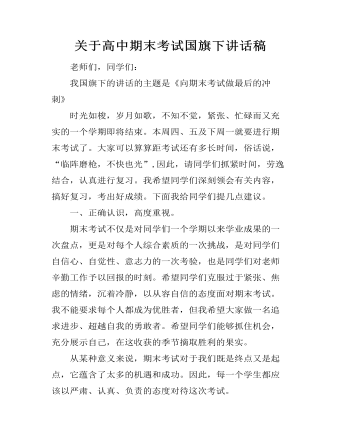
关于高中期末考试国旗下讲话稿
老师们,同学们:我国旗下的讲话的主题是《向期末考试做最后的冲刺》时光如梭,岁月如歌,不知不觉,紧张、忙碌而又充实的一个学期即将结束。本周四、五及下周一就要进行期末考试了。大家可以算算距考试还有多长时间,俗话说,“临阵磨枪,不快也光”,因此,请同学们抓紧时间,劳逸结合,认真进行复习。我希望同学们深刻领会有关内容,搞好复习,考出好成绩。下面我给同学们提几点建议。一、正确认识,高度重视。期末考试不仅是对同学们一个学期以来学业成果的一次盘点,更是对每个人综合素质的一次挑战,是对同学们自信心、自觉性、意志力的一次考验,也是同学们对老师辛勤工作予以回报的时刻。希望同学们克服过于紧张、焦虑的情绪,沉着冷静,以从容自信的态度面对期末考试。我不能要求每个人都成为优胜者,但我希望大家做一名追求进步、超越自我的勇敢者。希望同学们能够抓住机会,充分展示自己,在这收获的季节摘取胜利的果实。
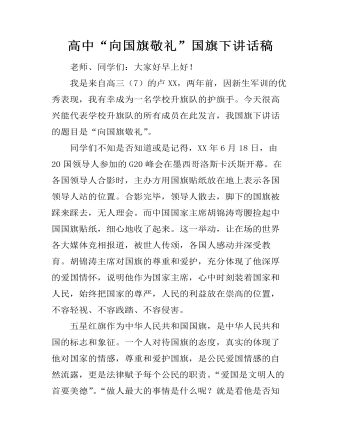
高中“向国旗敬礼”国旗下讲话稿
老师、同学们:大家好早上好!我是来自高三(7)的卢XX,两年前,因新生军训的优秀表现,我有幸成为一名学校升旗队的护旗手。今天很高兴能代表学校升旗队的所有成员在此发言,我国旗下讲话的题目是“向国旗敬礼”。同学们不知是否知道或是记得,XX年6月18日,由20国领导人参加的G20峰会在墨西哥洛斯卡沃斯开幕。在各国领导人合影时,主办方用国旗贴纸放在地上表示各国领导人站的位置。合影完毕,领导人散去,脚下的国旗被踩来踩去,无人理会。而中国国家主席胡锦涛弯腰捡起中国国旗贴纸,细心地收了起来。这一举动,让在场的世界各大媒体竞相报道,被世人传颂,各国人感动并深受教育。胡锦涛主席对国旗的尊重和爱护,充分体现了他深厚的爱国情怀,说明他作为国家主席,心中时刻装着国家和人民,始终把国家的尊严,人民的利益放在崇高的位置,不容轻视、不容践踏、不容侵害。五星红旗作为中华人民共和国国旗,是中华人民共和国的标志和象征。一个人对待国旗的态度,真实的体现了他对国家的情感,尊重和爱护国旗,是公民爱国情感的自然流露,更是法律赋予每个公民的职责。“爱国是文明人的首要美德”。“做人最大的事情是什么呢?就是看他是否知道怎样爱国”。
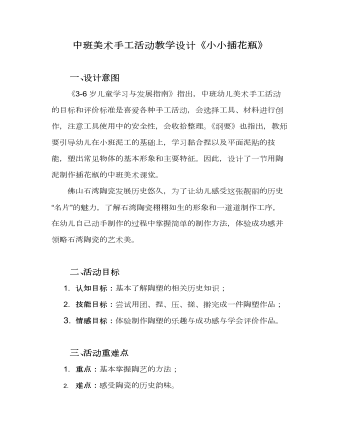
中班美术手工活动教学教案设计《小小插花瓶》
佛山石湾陶瓷发展历史悠久,为了让幼儿感受这张靓丽的历史“名片”的魅力,了解石湾陶瓷栩栩如生的形象和一道道制作工序,在幼儿自己动手制作的过程中掌握简单的制作方法,体验成功感并领略石湾陶瓷的艺术美。
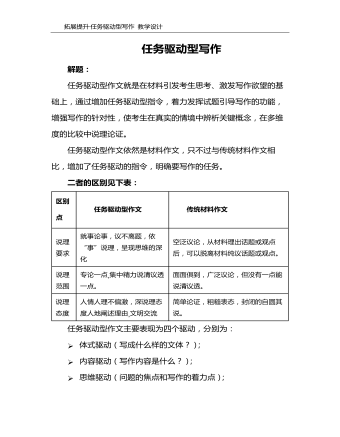
任务驱动型写作 教学教案设计
随着互联网自媒体的兴盛,不少人为了引起关注,吸引“粉丝”使出浑身解数。有人攀爬城市高楼,做出各种惊险动作,以赢得点击量;有“14岁荣升宝妈”的少女,靠展示自己的肚皮,获得打赏;9岁女孩在抖音发哭诉视频:“今天妈妈火化了,我再也见不到她了,求求你们,就给我一万个赞可以吗?”;有农村青年直播生吃青蛙、老鼠以求转发;有父亲虚构家庭处境,靠“卖惨”为“重病女儿”筹款……一个比一个奇异,一个比一个惊悚。
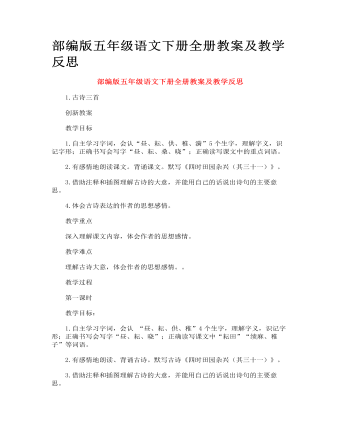
部编版五年级语文下册全册教案及教学反思
初读古诗,整体感知。 1.请同学们用自己喜欢的方式读古诗《四时田园杂兴》(其三十一)。要求借助拼音学会生字,把古诗读正确,读通顺。 2.指名多个学生朗读古诗,师生评议,纠正读得不准确的字音。尤其注意读准“昼、耘”的读音。指导读准多音字“供”([ gōng ]作动词时,准备着东西给需要的人应用:供应、供给(jǐ)、供求、供需、供销、提供、供不应求。[ góng ]奉献:供养、供献、供奉、供佛、供职;祭祀用的东西:供桌、供品、供果、上供;被审问时在法庭上述说事实:招供、口供、供状、供认、供词。)在诗中读四声。 3.把古诗反复多读几遍,通过查字典、问同学、问老师等方式,结合课文注释,理解诗句中词语的意思,用自己的话说说这首诗大体写了什么。记下不理解的地方和不明白的问题。 4.学生自愿举手发言,其他同学进行评议,也可以做补充发言。全班交流,教师相机引导并小结。

部编版二年级语文下册全册教案及教学反思
在入情入境中诵读成韵 1.配乐范读,想象画面: (1)学生边看插图边听老师配乐朗读,想象诗中所描绘的画面。 (2)学生自由交流想象中的画面,老师激励小结。 预设:山坡上的小草发芽了,嫩绿嫩绿的。黄莺在空中飞来飞去。河堤旁的柳条发芽了,几个下朋友放学回来,趁着东风,赶忙放起了风筝…… 2.借助插图,启发想象:黄莺一边飞一边干什么?(叽叽喳喳地叫)它好像在说什么? 再次启发想象:春风轻轻地吹来,柳条会怎样呢?(轻轻摆动,好像在跳舞陶醉在了美丽的春色里……) 诗人高鼎看到这样的景致写下了这样的诗句:出示“草长莺飞二月天,拂堤杨柳醉春烟”。(学生齐读) 让我们想象着春天的美丽景色,有滋有味地诵读。学生练读、指名读、引读。 3.联系生活,换位体验,:在这样美妙的春光里,沐浴着和煦的春风,(出示儿童放纸鸢图片)孩子们放起风筝,你们放过风筝吗?你放风筝时是怎样的心情?(学生自由发言)
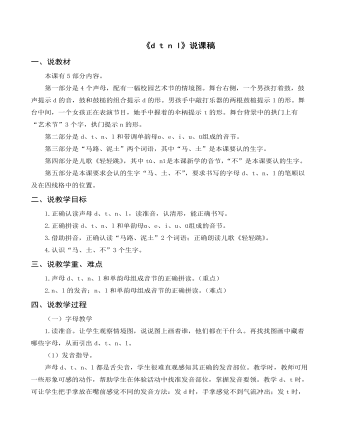
部编人教版一年级上册《d t n l》说课稿
(2)编儿歌练发音。教师要尽可能地利用与d、t、n、l发音相似的“的、特、呢、了”,编成儿歌,帮助学生较快地掌握发音要领。特别是声母n和l,初学时不少学生很容易混淆,可以编一些顺口溜,帮助学生加以区别。2.识记形。(1)观察字形。教师引导学生再次细致观察情境图,说一说d、t、n、l的形体各自有什么特点。告诉学生:d就像鼓和鼓槌组合在一起的样子,t就像女孩手中握着的伞柄,n就像舞台背景拱门的样子,l就像男孩手中的鼓槌。(2)形近字母辨析。d、t、n与前一课所学的b、f、m形体有相似之处,学生很容易混淆。可以让学生通过合作探究的学习方式,弄清它们之间的区别。在学生掌握读音后,出示d、t、n与b、f、m,让他们细细观察,反复比较,小组讨论得出它们的不同点:左下半圆是d,右下半圆是b,一根鱼竿是t,一根拐杖是f,一个门洞是n,两个门洞是m。教师还可以在课堂上展示雨伞实物:伞柄朝上就是t,伞柄朝下就是f。也可以启发学生编顺口溜,帮助记忆新学的字母,如,小鼓敲响ddd,伞柄朝上ttt,一个门洞nnn,一根小棍lll。

新人教版高中英语必修2Unit 4 History and Traditions-Listening&Speaking&Talking教案一
This unit is about history and traditions. From the opening page, we can know that this unit will introduce the history and traditions around the world. As Marcus Garvey says “A people without the knowledge of their past history, origin and culture is like a tree without roots”, it is important for students to realize the importance and value of knowing the history and traditions and their further meanings. And this part ( listening and speaking ) is divided into two parts: Part A---share views on historic sites, Part B ---talk about a visit to a historic tourist destination. By talking with a foreigner, the speakers introduce the historic attractions and their cultures. Part A is that William, a British student, who was going to visit the Confucius Temple and a Chinese student, Xiao Kong, who was going to the Confucius Temple to meet with the members of the research group, went together and exchanged their views on the Confucius Temple, Confucius, Confucius' descendants and Confucius' educational thoughts. Part B is a conversation between Xiao Yan, a youth hostel receptionist and Paul, a backpacker about the feelings and experience after visiting the Chinese famous tourist attraction Pingyao.1. Guide students to understand the content of listening texts in terms of the whole and key details; 2. Cultivate students' ability to guess the meaning of words in listening; discuss with their peers how to talk about historic spots and great person.3. Instruct students to use functional sentences of showing one’s excitement, surprise and disappointment.1. Guide students to understand the content of listening texts in terms of the whole and key details; 2. Cultivate students' ability to discuss with their peers the related topics.3. Enable students to use the functional items of showing one’s excitement, surprise and disappointment.

新人教版高中英语必修2Unit 4 History and Traditions-Reading and Thinking教案二
Step 5 While reading---Task 3Read the text again and answer the following questions.Q1: How many countries does the UK consist of ?4 Q2: What are the four countries of the United Kingdom?England, Wales, Scotland and Northern Ireland Q3: Which two were the first to be joined together ?England and WalesQ4: What are the two chief advantages of studying the history of a country ?The first one is to help you understand more about the country and its traditions.The second one is to make visiting it more enjoyable.Q5: What’s the author’s attitude towards studying the history ?Supportive/positiveStep 6 Post reading---Retell the textThe United Kingdom, Great Britain, Britain, England—many people are confused by (1)_____ these different names mean. In the 16th century, the nearby country of Wales (2) __________(join) to the Kingdom of England. In the 19 th century, the Kingdom of Ireland was added to create the United Kingdom of Great Britain and Ireland. Finally, the southern part of Ireland (3) ______ (break) away from the UK, which resulted in the full name we have today. However, most people just use the (4)_________(shorten) name: the UK. The four countries (5)__________ belong to the United Kingdom work together in some areas. There were four sets of invaders and the last group were the Normans. They had castles (6)_________(build) all around England and made changes (7)__________ the legal system. Studying the history of the country will make your visit much more (8)_________(enjoy). The capital city London is (9)___ ancient port city that has a history (10)______(date) back to Roman times. 1. what 2.was joined 3.broke 4.shortened 5.that 6. built 7.to 8.enjoyable 9.an 10.dating Step 6 Homework

新人教版高中英语必修2Unit 4 History and Traditions-Listening&Speaking&Talking教案二
Listening and Speaking introduces the topic of “Take part in a youth project”. The listening text is an interview about "sharing views on historical sites". Through listening to a dialogue between Chinese and foreign students on the way to the Confucius Temple, students can understand their views on the Confucius Temple, Confucius, Confucius' descendants and Confucius' educational thoughts, so as to realize and think about the profound influence of Confucius and his thoughts on Chinese historical tradition. At the same time, the dialogue naturally integrates English idioms and mentions Shakespeare, the British playwright, so as to provide language materials and context for students to understand English idioms and related cultural allusions, as well as to compare Chinese and foreign cultures, which is helpful for students to understand and express the language such as history, tradition, culture and custom significant impact.Text analysis: listening text is a dialogue between a British student and a Chinese student when he goes to the Confucius Temple. When William, a British student, visited the Confucius Temple, he asked Xiao Kong, a Chinese student, for directions. Xiao Kong was just going to the Confucius Temple to meet with the members of the research group, so they went together and exchanged their views on the Confucius Temple, Confucius, Confucius' descendants and Confucius' educational thoughts. From the perspective of foreign tourists, this paper describes their thoughts on Confucius, the great son of Confucius, who had a profound impact on Chinese history and cultural tradition, and his education.Listening and Talking introduces a visit to a historic tourist destination. Tourism is a common way to understand a country's history, culture, and customs and so on. Students listen to the dialogue between Xiao Yan, a youth hostel Usher, and Paul, a backpacker, to learn about Pingyao's famous historical and cultural attractions and Paul's travel experience and experience as a foreign tourist.

新人教版高中英语必修2Unit 4 History and Traditions-Reading and Thinking教案一
Features of languages1.Finally, in the 20th century, the southern part of Ireland broke away from the UK, which resulted in the full name we have today: the United Kingdom of Great Britain and Northern Ireland.该句是一个复合句。该句主句为:the southern part of Ireland broke away from the UK;which resulted in the full name we have today为which引导的定语从句代指前面整句话的内容,we have today为定语从句修饰先行词name。译文:最后,在20世纪,爱尔兰南部脱离英国,这导致了我们今天有的英国的全名:大不列颠及北爱尔兰联合王国。2.Almost everywhere you go in the UK, you will be surrounded by evidence of four different groups of people who took over at different times throughout history.该句是一个复合句。该句主句为:you will be surrounded by evidence of four different groups of people;其中Almost everywhere you go in the UK为让步状语从句; who took over at different times throughout history为定语从句修饰先行词people。译文:几乎无论你走到英国的任何地方,你都会发现历史上有四种不同的人在不同的时期统治过英国。3.The capital city London is a great place to start, as it is an ancient port city that has a history dating all the way back to Roman times.该句是一个复合句。该句主句为:The capital city London is a great place to start; as it is an ancient port city that has a history dating all the way back to Roman times.为原因状语从句;dating all the way back to Roman times为现在分词短语作定语修饰history。

新人教版高中英语必修2Unit 4 History and Traditions-Discovering Useful Structure教案一
Step 5 Practice一、完成下列句子。1. Judy and I _______________(把车停下来(park))in an underground car Park near Trafalgar Square, where we could ______________________(让我们的车充电(charge)).2. When we finally reached the service desk to ask for audio guides, we heard it ___________ that there were no audio guides____________(留下,剩下).3. We__________________________(发现自己对...很惊讶)the large number of visitors and the amount of noise at the entrance of the National Gallery.4. Judy ____________________(眼神专注于) Van Gogh’s Sunflowers. It was hard to approach the painting as there were so many people around.5. She ____________________(把这幅画的复制品装箱(box)) to ensure that it was delivered safely.答案:1.had our car parked get our car battery charged 2. announced left 3. found ourselves very surprised 4. had her eyes fixed on 5. had a copy of the painting boxed二、用过去分词对下列句子进行改写。1. Loch Ness was surrounded by beautiful natural landscape, which made it look amazing.2. Carl and his friend stayed with a generous family who offered them bread with butter and honey that was homemade.3. The family’s ancestors once attended to soldiers who were wounded in the First World War.4. The young people were attracted by the legend of Loch Ness. They watched over the lake with their cameras and binoculars, which were positioned on the hill.答案:1. Loch Ness surrounded by beautiful natural landscape looks amazing.2. Carl and his friends stayed with a generous family who offered them homemade bread with butter and honey.3. The family’s ancestors once attended to wounded soldiers in the First World War.4. The young people attracted by the legend of Loch Ness watched over the lake with their cameras and binoculars positioned on the hill.

新人教版高中英语必修2Unit 4 History and Traditions-Discovering Useful Structure教案二
This teaching period mainly deals with grammar: The past participle is used as attributive and objective complement.1. Guide students to review the basic usages of the past participle used as attributive and objective complement.2. Lead students to learn to use some special cases concerning the past participle used as attributive and objective complement flexibly.3. Strengthen students’ great interest in grammar learning.1. Help students to appreciate the function of the past participle used as attributive and objective complement.2. Instruct students to write essays using the past participle used as attributive and objective complement.Step1:温故而知新。Analyze the underlined phrases and then sum up the common usages of the past participles.1.(教材P41)They had castles built(build) all around England, and made changes to the legal system.2.(教材P42)They use the same flag, known(know) as the Union Jack,...3.(教材P42)Judy and I had our car parked(park) in an underground car park near Trafalgar Square, where we could get our car battery charged(charge).Common points: f the past participle used as attributive and objective complement.Step 2:过去分词作定语时的意义1.及物动词的过去分词作定语,在语态上表示被动;在时间上,常表示动作已经发生或完成,有时也不表示时间性。Our teacher watched us doing the experiment and gave us a satisfied smile at last.我们的老师看着我们做实验,最后给了我们一个满意的微笑。The plan put forward at the meeting will be carried out soon.会上提出的计划将很快被执行。2.不及物动词的过去分词作定语,它不表示被动意义,只强调动作完成。Many little kids like gathering fallen leaves in the yard.

新人教版高中英语必修2Unit 4 History and Traditions-Reading for Writing教案
Step 1 Lead inThere are many interest of places in the UK. What do you know ?The Big Ben the London Tower the Thames RiverStep 2 Before reading---analyze the titleBeautiful Ireland and its traditionWe know that the article mainly tells about the beauty and traditions of Ireland. Step 3 While reading---Task 1Read the text and answer the following questions.Q1: What makes the Irish countryside exciting and inspiring?Its beauty and how it offers something for all the scenes.Q2: What are the best ways to experience some Irish traditions and cultures?By stopping by a village pub and relaxing with a drink and traditional meal while listening to music and watching dancingQ3: What is the meaning of “breathe in the sweet scent of fresh flowers while birds greet the new day with their morning song ?”It means to not just smell but also breathe in the smell of fresh flowers early in the morning as the birds sing their first song of the new day.Q4: What are the best ways to experience Chinese traditions and customs ?By travelling to different places and using all your senses to experience everything and by interacting with local people.Step 4 While reading---Task 2Analyze the descriptive paragraph1. Identify and underline the paragraph’s introductory sentence and the ending sentence.Introductory sentence: Ireland’s beautiful countryside has always had a great influence on its people and traditions.Ending sentence: And if you introduce yourself to a friendly face, you are more than likely to experience local culture and customs first-hand.2. The paragraph talks about different senses in different places. Write the senses and places in the order that they appear.